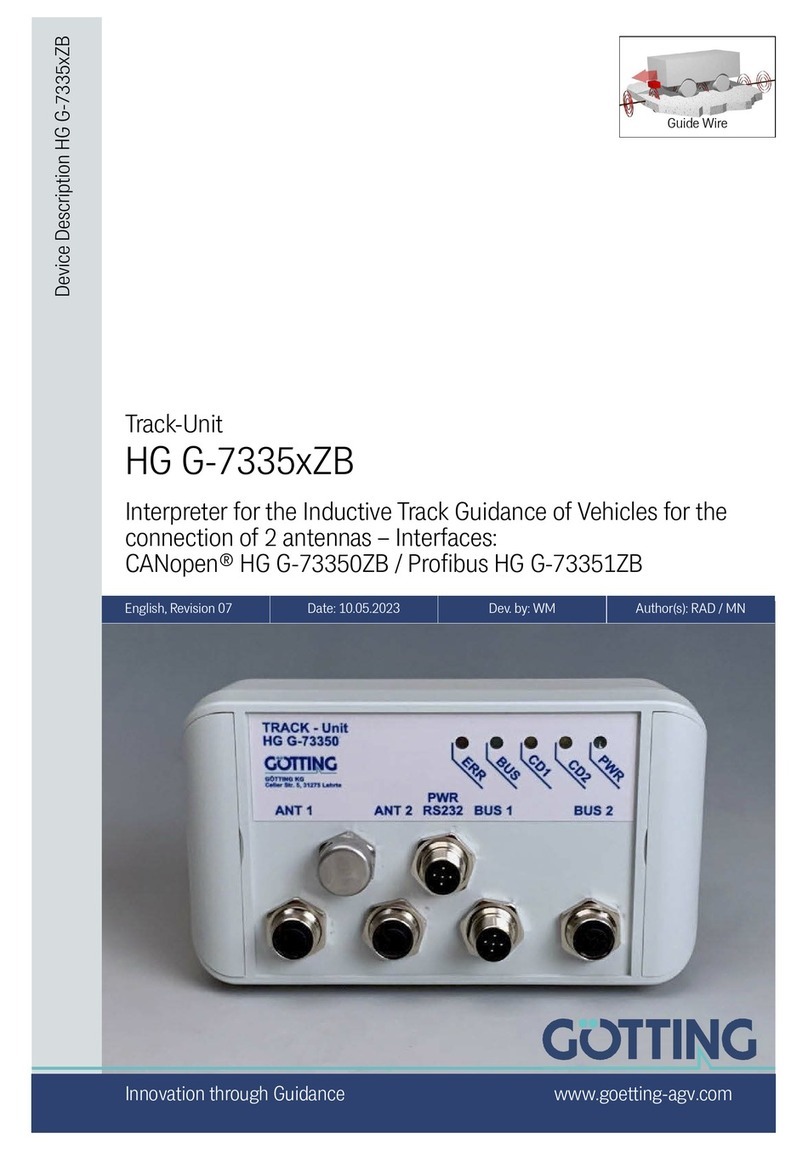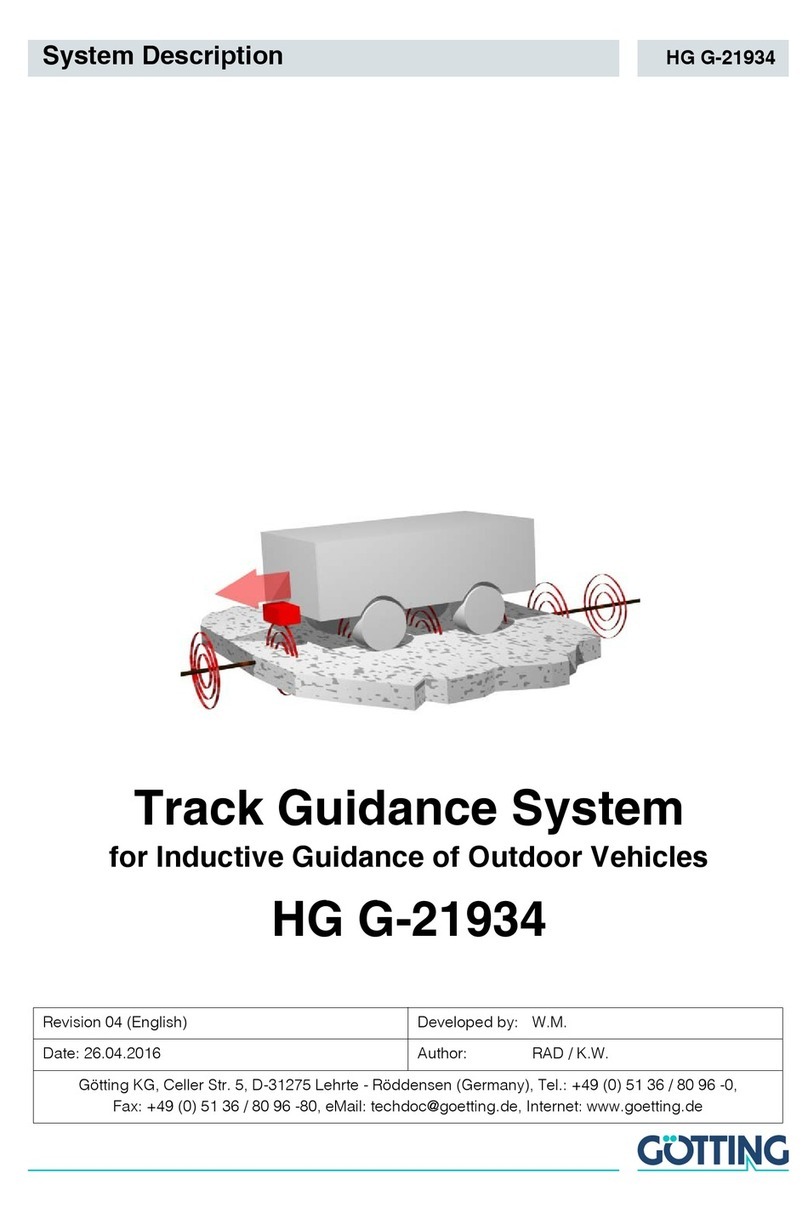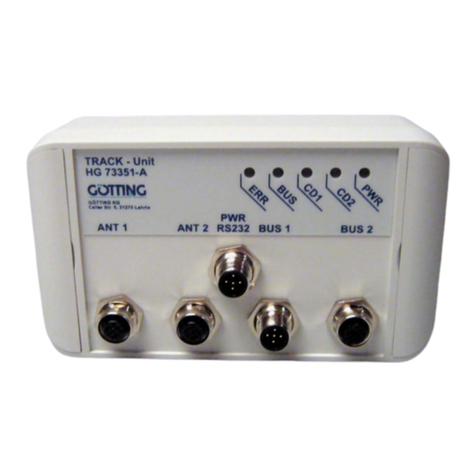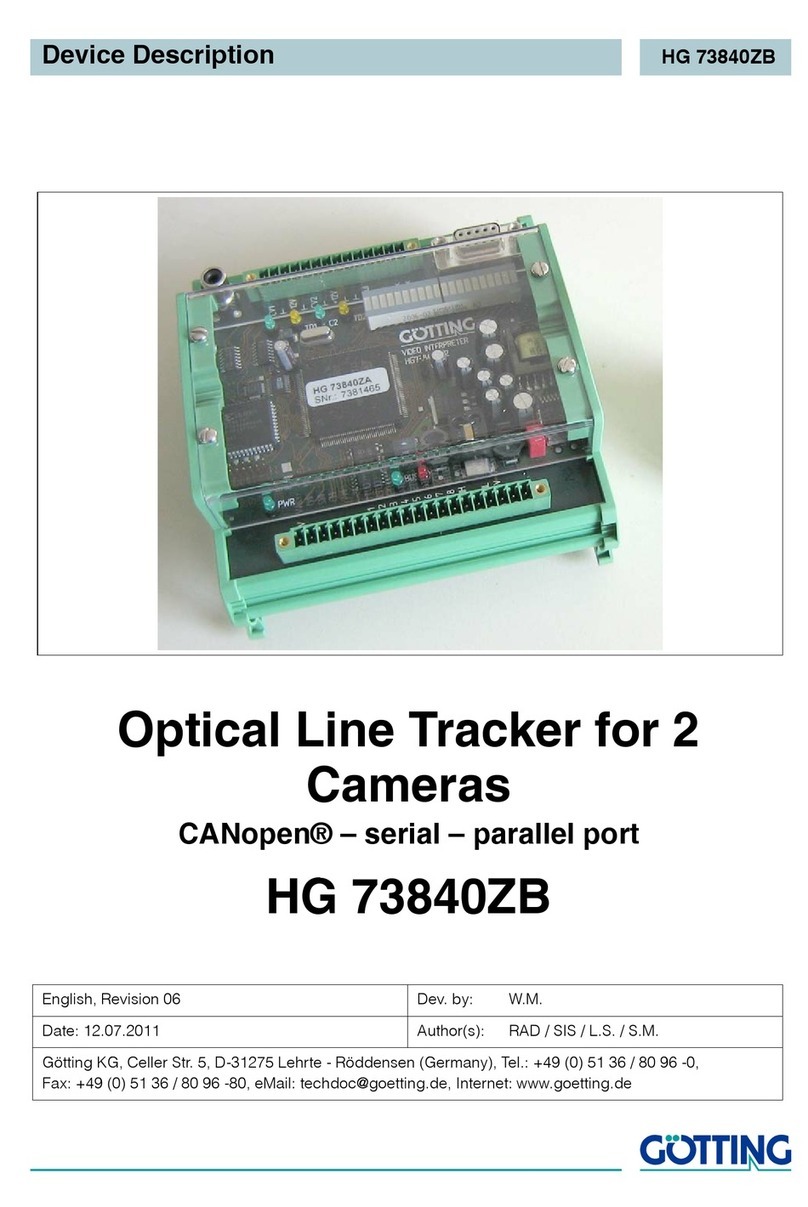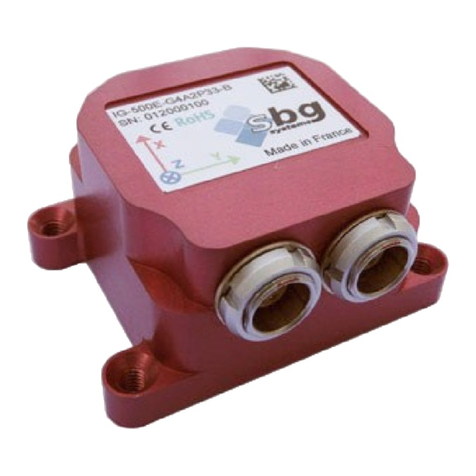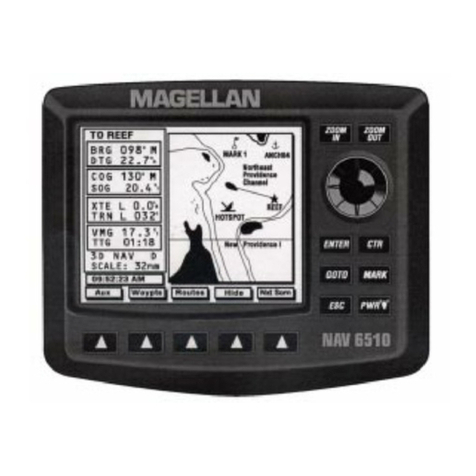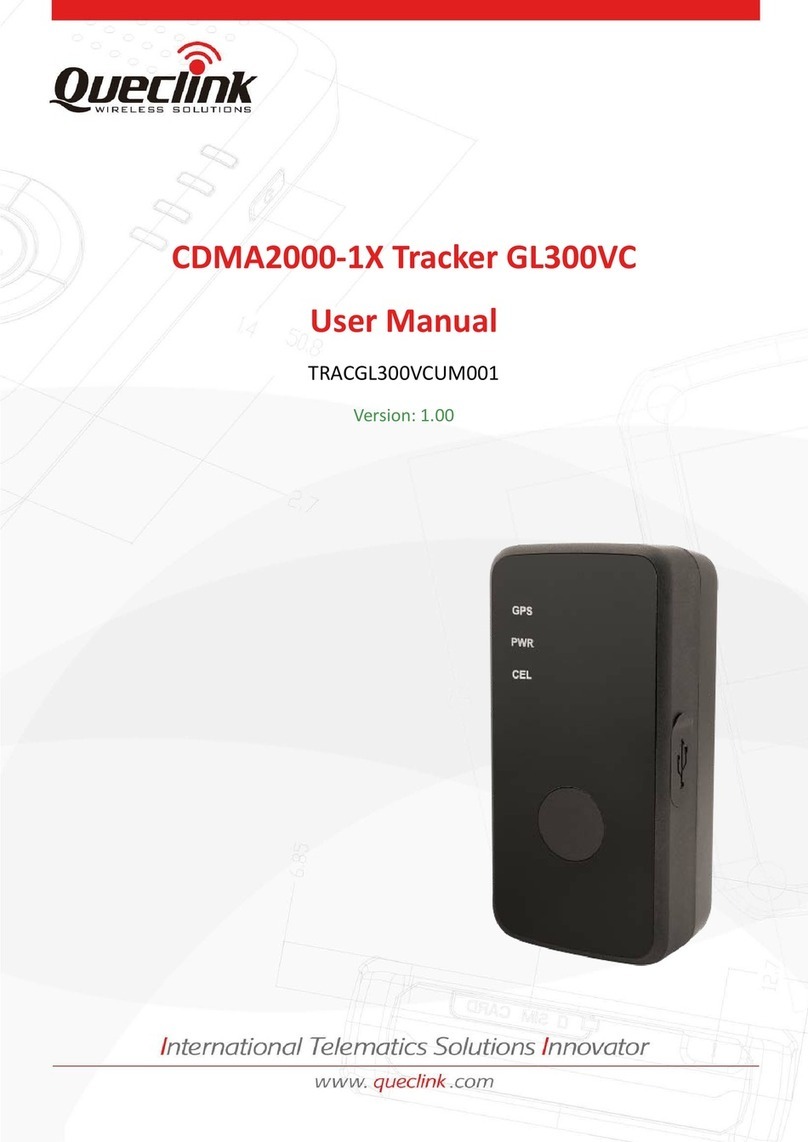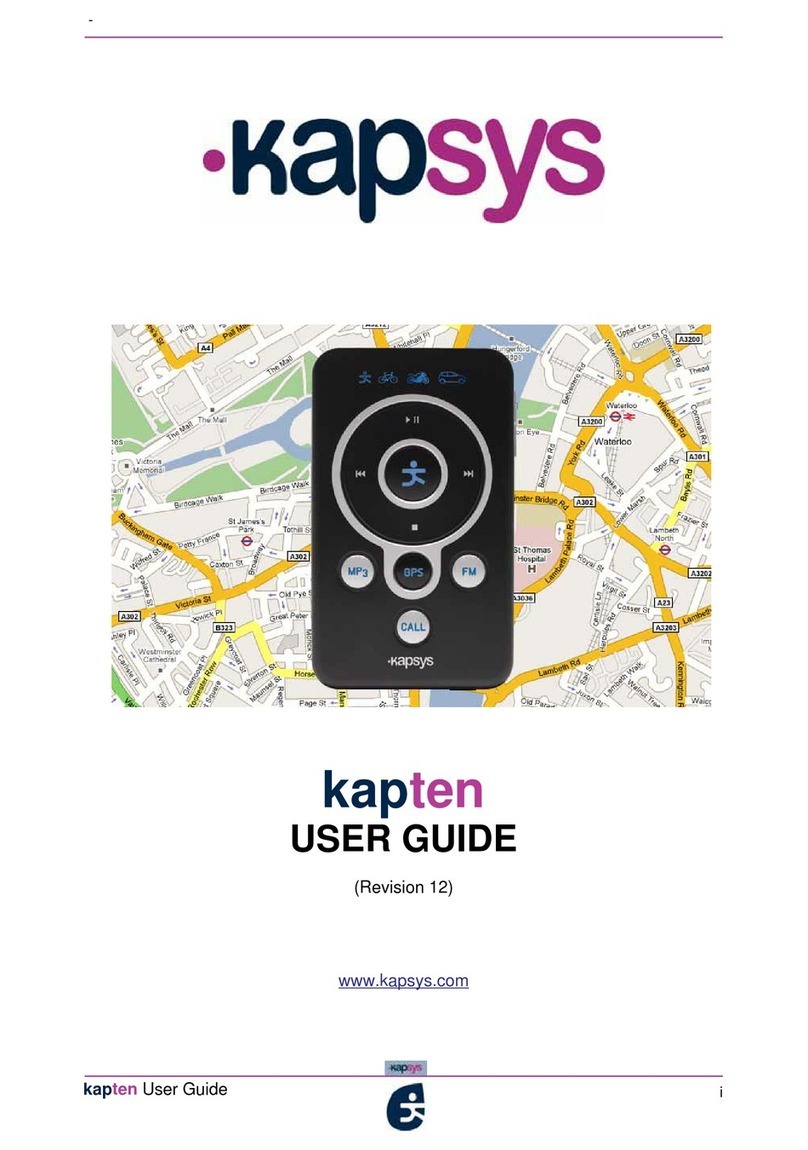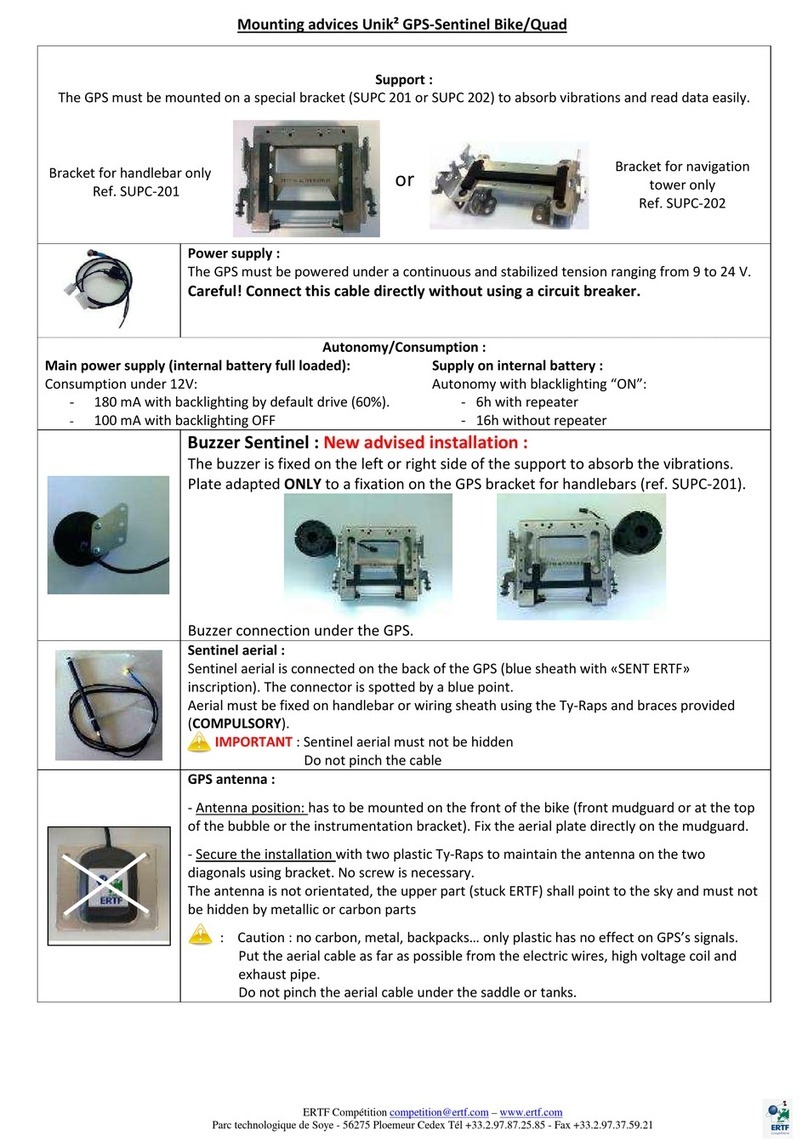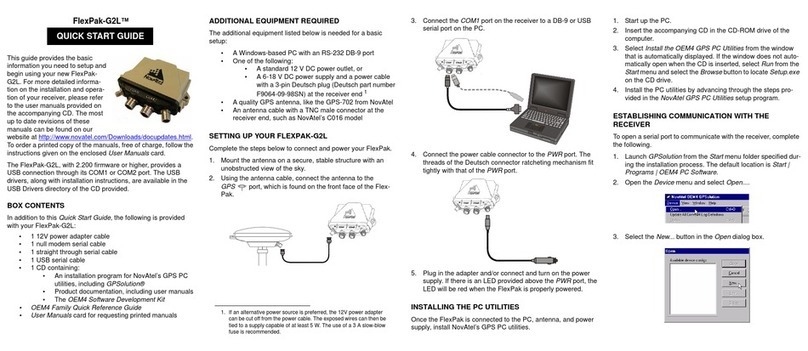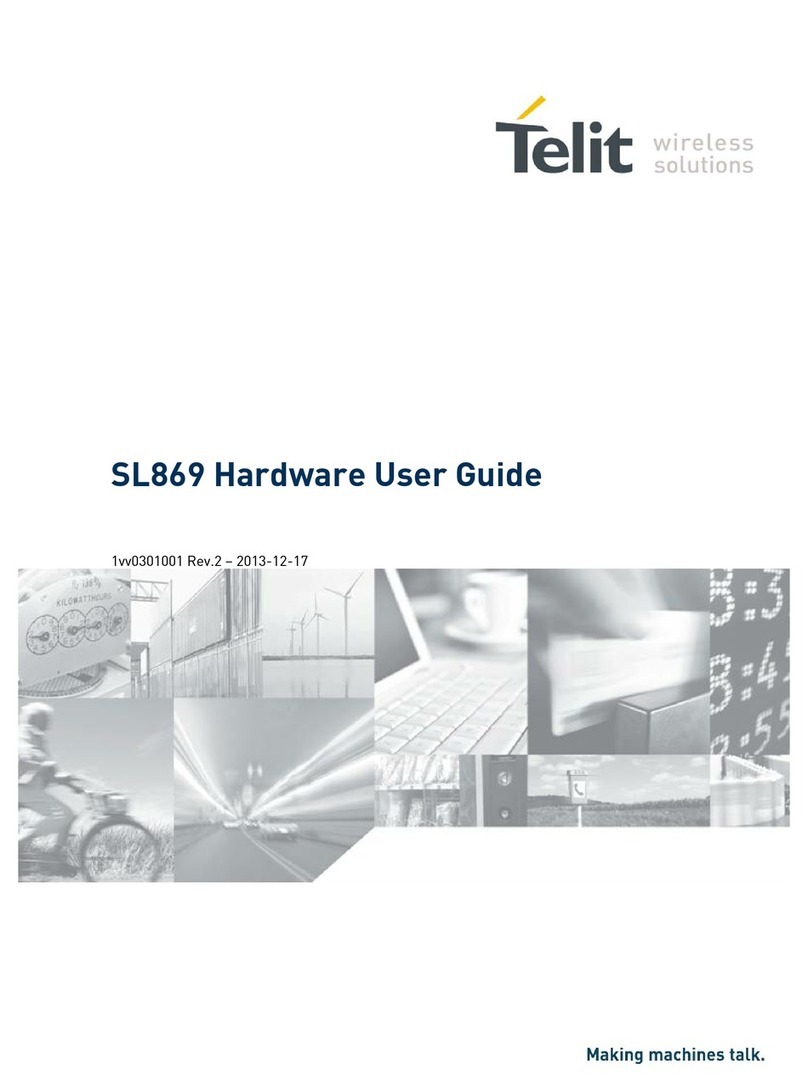Gotting HG G-7335 ZB Series User manual

Track-Unit
HG G-7335xZB
Interpreter for the Inductive Track Guidance of Vehicles for the
connection of 2 antennas – Interfaces:
CANopen® HG G-73350ZB / Profibus HG G-73351ZB
English, Revision 06 Date: 30.04.2020 Entw. von: WM Autor(en): RAD / MN
Guide Wire
www.goetting-agv.com
Innovation through Guidance
Device Description HG G-7335xZB

Device Description HG G-7335xZB | English, Revision 06 | Date: 30.04.2020
2Overview
Basic characteristics of the Track-Units HG G-73350ZB (CAN bus) and
HG G-73351ZB (Profibus)
Interpreter for inductive track guidance systems
For the connection of 2 guidance antennas
2 identical channels with independent filter frequency setting
Monitoring of connected antennas for correct operation and wire breakage
Interfaces:
- RS 232 service interface (all variants)
- CAN/CANopen® (HG G-73350)
- Profibus (HG G-73351)
Configuration via terminal program (RS 232) or via CAN-open® SDOs
© 2020 Götting KG, errors and modifications reserved.
The Götting KG in D-31275 Lehrte has
a certified quality management system
according to ISO 9001.

Device Description HG G-7335xZB | English, Revision 06 | Date: 30.04.2020
3
Table of Contents
Content
1 About this Document........................................................................ 5
1.1 Validity...................................................................................................................................... 5
1.1.1 Target Group ...................................................................................................................... 5
1.1.2 Other Applicable Documents........................................................................................ 5
1.2 Declaration of Conformity (only HG G-73350) ............................................................ 6
1.3 Presentation of Information .............................................................................................. 6
1.3.1 Warning Notices ............................................................................................................... 6
1.3.2 Symbols ............................................................................................................................... 7
2 Safety Instructions ........................................................................... 8
2.1 Intended Use .......................................................................................................................... 8
2.2 Improper Use.......................................................................................................................... 8
2.3 Qualification of the Users ................................................................................................... 9
2.4 Operating Conditions........................................................................................................... 9
2.5 General Safety Instructions ............................................................................................. 10
2.6 Obligations of the Operator ............................................................................................. 10
3 Introduction..................................................................................... 12
3.1 Variant Overview.................................................................................................................12
3.2 System Components..........................................................................................................12
3.3 Accessories ........................................................................................................................... 12
4 Mounting ......................................................................................... 14
4.1 Casing Dimensions .............................................................................................................14
4.2 Connectors............................................................................................................................14
4.2.1 Antenna Sockets on the Interpreter ......................................................................... 14
4.2.2 CAN Bus (HG G-73350) ................................................................................................15
4.2.3 Profibus (HG G-73351) .................................................................................................15
4.2.4 Power supply and serial interface ............................................................................. 16
5 Commissioning ............................................................................... 17
6 Hardware ......................................................................................... 18
6.1 Monitoring.............................................................................................................................18
6.2 Presettings ............................................................................................................................18
6.3 Processing the Signal ........................................................................................................18
6.4 The Control LEDs ................................................................................................................19
6.4.1 CAN Bus (HG G-73350) ................................................................................................19
6.4.2 Profibus (HG G-73351) .................................................................................................19
7 Software .......................................................................................... 20
7.1 Connection to a PC via the Serial Interface................................................................20
7.2 Terminal Program ...............................................................................................................20
7.3 Monitor Program .................................................................................................................20
7.3.1 Main Menu........................................................................................................................20
7.3.2 Antenna Menu .................................................................................................................23
7.3.3 CAN Menu (HG G-73350)............................................................................................. 24
7.3.4 Profibus Menu (HG G-73351) ..................................................................................... 26
7.4 Switching to Different Environment Parameters ......................................................26
7.5 Firmware-Update ................................................................................................................26
8 CAN Interface (HG G-73350) .......................................................... 28
8.1 Definition of the Terms CAN and CANopen® ............................................................28
8.2 Description of the Process Data Objects (PDOs) ......................................................30
8.2.1 Transmission Objects....................................................................................................30
8.2.1.1 PDO_1 ...........................................................................................................................30
8.2.1.2 PDO_2 ...........................................................................................................................32

Device Description HG G-7335xZB | English, Revision 06 | Date: 30.04.2020
4Table of Contents
8.2.2 Receiving Objects...........................................................................................................32
8.3 Heartbeat ...............................................................................................................................33
8.4 Writing on Service Data Objects (SDOs) .....................................................................33
8.5 Object Directory ..................................................................................................................33
8.5.1 Communication specific entries ................................................................................34
8.5.2 Manufacturer entries .....................................................................................................35
8.5.3 Standard device profile.................................................................................................36
8.5.4 CANopen Object Dictionary ........................................................................................36
8.5.4.1 Device Type..................................................................................................................36
8.5.4.2 Error Register...............................................................................................................36
8.5.4.3 COB-ID SYNC message ............................................................................................37
8.5.4.4 Device Name................................................................................................................37
8.5.4.5 Hardware Version.......................................................................................................37
8.5.4.6 Software Version ........................................................................................................37
8.5.4.7 Save Parameter...........................................................................................................37
8.5.4.8 Restore Default Parameter......................................................................................38
8.5.4.9 Producer Heartbeat Time.........................................................................................38
8.5.4.10 Identity Object.............................................................................................................38
8.5.4.11 Receive PDO Parameter ...........................................................................................39
8.5.4.12 Mapping RPDO_1.......................................................................................................39
8.5.4.13 Transmit PDO_1 Parameter ....................................................................................39
8.5.4.14 Transmit PDO_2 Parameter ....................................................................................40
8.5.4.15 Mapping TxPDO_1 .....................................................................................................40
8.5.4.16 Mapping TxPDO_2 .....................................................................................................41
8.5.4.17 Manufacture Parameter - parameters of the antenna ....................................41
8.5.4.18 Manufacture parameter - calibration of the antenna......................................42
8.5.4.19 Manufacture parameter - node parameter.........................................................43
8.5.4.20 8 Bit Digital Input (transmitted in TxPDO 1) ......................................................43
8.5.4.21 16 Bit Analog Inputs (transmitted in TxPDO 1 und TxPDO 2)......................44
9 Profibus Interface (HG G-73351) ...................................................45
10 Troubleshooting ..............................................................................46
11 Technical Data.................................................................................47
12 Appendix ..........................................................................................48
12.1 Block Diagrams....................................................................................................................48
12.2 Diagrams................................................................................................................................49
12.3 Electronic Data Sheet (EDS File, HG G-73350)..........................................................52
12.4 GSD File (HG G-73351) .....................................................................................................52
13 List of Figures..................................................................................53
14 List of Tables ...................................................................................54
15 Index ................................................................................................56
16 Copyright and Terms of Liability....................................................58
16.1 Copyright ...............................................................................................................................58
16.2 Exclusion of Liability ..........................................................................................................58
16.3 Trade Marks and Company Names ...............................................................................58

Device Description HG G-7335xZB | English, Revision 06 | Date: 30.04.2020
5
About this Document – Chapter 1
1About this Document
1.1 Validity
This device description applies to the interpreter HG G-7335xZB.
It contains information on correct mounting, electrical installation, commissioning,
operation, maintenance and fault rectification.
This device description refers to devices from firmware as specified in section 3.1 on
page 12.
The operation of the interpreter is only reasonably possible together with Götting an-
tennas (see section 3.1 on page 12) and a current-carrying guide wire in the ground.
In combination with connected antennas and the guide wire we speak of a track
guidance system. In the following we will therefore speak of the interpreter (device)
or the system, depending on the context.
1.1.1 Target Group
This device description is intended for developers, manufacturers or operators of
systems or facilities that want to track guide Automated Guided Vehicles (AGV). It is
also intended for qualified personnel who
wants to integrate the system into a vehicle.
wants to carry out the initial commissioning of the system.
want to configure the system.
1.1.2 Other Applicable Documents
This device description does not include information on the operation of the higher-
level system, e.g. an automated guided vehicle (AGV), into which the evaluator is in-
tegrated.
Do not put the interpreter and the associated Götting antennas into operation
until you have received the operating instructions from the manufacturer or the
system operator and have read and understood them.
Supplementary documents for devices from Götting are available
on request or directly via our Internet pages. The adjacent QR code
will lead you to our homepage www.goetting-agv.com. The follow-
ing links refer to specific product pages.
–Antenna type HG G-19200
http://www.goetting-agv.com/components/19200
–Antenna type HG G-19535
http://www.goetting-agv.com/components/19535

Device Description HG G-7335xZB | English, Revision 06 | Date: 30.04.2020
6Chapter 1 – About this Document
1.2 Declaration of Conformity (only HG G-73350)
The product HG G-73350 complies with the relevant harmonisation legislation of
the European Union. The relevant harmonized European standards and directives
mentioned in the Declaration of Conformity were used to assess conformity.
You can request the EU declaration of conformity from Götting KG
or download it under the following link.
https://www.goetting-agv.com/components/7335x
1.3 Presentation of Information
For you to be able to use your product simply and safely this device description uses
consistent warning notices, symbols, terms and abbreviations. Those are described
in the following sections.
1.3.1 Warning Notices
In this device description warning notices appear before sequences of actions that
may lead to damage to persons or property. The listed actions for the danger preven-
tion have to be observed.
Warning notices have the following structure:
The warning symbol (warning triangle) indicates danger to life or risk of injury.
The signal word indicates the severity of the danger.
The paragraph kind or source of the danger names the kind or source of the
danger.
The paragraph consequences describes the consequences of not observing
the warning notice.
The paragraphs for danger prevention explain, how to avoid the danger.
SIGNAL WORD
Kind or source of the danger
Consequences
Danger prevention

Device Description HG G-7335xZB | English, Revision 06 | Date: 30.04.2020
7
About this Document – Chapter 1
The signal words have the following meanings:
1.3.2 Symbols
In this device description the following symbols and formatting are used:
If this information is ignored,
the product may not be operated in an optimal way.
Indicates one or more links to the Internet.
–www.goetting.de/xxx
–www.goetting.de/yyy
Indicates tips for easier
operation of the product.
The check mark lists a requirement.
The arrow shows an action step.
The indentation shows the result of an action or an action sequence.
Program texts and variables are indicated through the use of a fixed width
font.
Menu items and parameters are shown in cursive characters.
Whenever the pressing of letter keys is required for program entries, the
required etter eys are indicated as such (for any programs of Götting KG
small and capital letters are equally working).
Table 1 Hazard classification according to ANSI Z535.6-2006
Warning Symbol, Signal Word Meaning
DANGER
DANGER indicates a hazardous situation
which, if not avoided, will result in death or
serious injury.
WARNING
WARNING indicates a hazardous situation
which, if not avoided, could result in death or
serious injury.
CAUTION
CAUTION indicates a hazardous situation
which, if not avoided, could result in minor or
moderate injury.
NOTICE
NOTICE indicates property damage: The
product or the environment could be dam-
aged.

Device Description HG G-7335xZB | English, Revision 06 | Date: 30.04.2020
8Chapter 2 – Safety Instructions
2Safety Instructions
This product has been manufactured in accordance with the generally recognized
rules of technology. Nevertheless, there is a risk of personal injury and material dam-
age if you do not observe this chapter and the safety instructions in this documen-
tation.
Read this documentation thoroughly and completely before working with the
product.
Store the documentation in such a way that it is always accessible to all users.
Always pass on the product to third parties together with the required docu-
mentation.
2.1 Intended Use
The interpreter is a component of guide wire track guidance systems for Automated
Guided Vehicles. The interpreter detects the deviation from the guide wires laid in
the ground by means of the antennas mentioned in section 3.1 on page 12 and
transmits it to the vehicle controller. Based on the transmitted values the steering in-
formation can be calculated.
The connected antennas are monitored for correct operation as well as for wire
breakage. The interpreter is only intended for the use in track guidance systems with
a maximum speed of 1 m/s without any passenger transportation.
Main area of application is the steering of automated guided vehicles, thus this is the
application we mainly address from here on.
The track guidance system may only be operated by qualified personnel at the oper-
ation place (e.g. vehicle) at which it was mounted or initially commissioned by qual-
ified personnel according to this device description. The operating conditions given
in section 2.4 on page 9 have to be observed.
The track guidance system does not include safety equipment. It may only be used
in applications where the manufacturer and/or the facility operator have ensured
that sufficient measures for ensuring the personal safety and the safe detection of
obstacles have been established. This includes the safe detection of situations like
e.g. the vehicle leaving the track or people or obstacles appearing in front of the ve-
hicle. In these cases moving parts (e.g. vehicles) have to be stopped immediately to
rule out material damage and personal injuries.
All persons within the range of influence of an automated facility (e.g. automated
guided vehicle, AGV) have to be instructed about the kind of the application and the
associated risks.
2.2 Improper Use
Any use other than that described in the intended use is not intended and therefore
not permitted.
Götting KG does not accept any liability for damage caused by improper use. The
risks of improper use lie solely with the user.

Device Description HG G-7335xZB | English, Revision 06 | Date: 30.04.2020
9
Safety Instructions – Chapter 2
Improper use includes:
The use of the track guidance system in vehicles that are not equipped with
safety devices for personal protection and safe detection of obstacles.
Any departure from the lane or the appearance of a person or an obstacle in the
danger area must be reliably detected at all times and immediate stopping of
moving parts (e.g. vehicles) must be ensured to prevent damage to property or
persons.
2.3 Qualification of the Users
The tasks described in this document require basic knowledge of the mechanics and
electrics as well as knowledge of the associated technical terms. In order to ensure
safe use, these activities must therefore only be carried out by an appropriate spe-
cialist or an instructed person under the supervision of a specialist.
A qualified person is someone who, on the basis of his or her specialist training,
knowledge and experience as well as knowledge of the relevant regulations, is able
to assess the work assigned to him or her, recognize possible dangers and take ap-
propriate safety measures. A qualified person must comply with the relevant tech-
nical regulations.
The personnel intended for the installation, commissioning and configuration of the
track guidance system:
has received a copy of this device description.
is familiar with the functionality of the superordinate system (e.g. an automated
vehicle).
is qualified to perform their tasks and is sufficiently trained to mount and con-
figure the track guidance system, if that is part of their tasks.
is familiar with the commissioning of and the telegram exchange via CAN bus
or Profibus connections.
knows – in case the track guidance system is to be used to position automated
vehicles – the dangers emanating from an Automated Guided Vehicles (AGV)
and is sufficiently trained in handling the vehicle and any necessary safety pre-
cautions to assess the safe working condition of the system.
knows – in the event that other equipment or systems with moving parts are
used – the risks arising from the application and is sufficiently trained in the
handling of the vehicle and any necessary safety precautions to assess the safe
working condition of the system.
2.4 Operating Conditions
Observe the conditions for the installation of the antenna given in the related
documents (s. section 1.1.2 on page 5), especially the specifications for metal
free areas around the antenna and the interference immunity.
Reinforcements close to the surface of the roadway may interfere the antenna
and thus distort the position detection. This also applies to any large metal
pieces (sheets) on the ground, the proximity of any floor reinforcement and
inductive loops, as they are created e.g. by steel building mats. Individual metal
poles have little effect. Those may partially be within the metal-free area of the
guide wire.
For the size of metal-free areas around the antenna please see the appropriate
data-sheets listed in section 1.1.2 on page 5.

Device Description HG G-7335xZB | English, Revision 06 | Date: 30.04.2020
10 Chapter 2 – Safety Instructions
The nominal reading distance between antenna and wire depends on the
antenna type and the wire current. In between antenna and guide wire there
may be no metal. Non-conducting and non-shielding dirt on the roadway as
well as water, oil, tar, earth, fog, snow and ice do not influence the positioning.
Even though dirt does not influence the positioning the antenna should be pro-
tected against dirt and moisture (e.g. spray water from the vehicle‘s wheels) and
cleaned regularly. Otherwise the antenna‘s attrition rate rises.
The antenna has to be fixed to the vehicle so firmly that its position does not
change during normal operation. Otherwise the superordinate system interprets
the position data wrongly and the vehicle might e.g. drive besides the track.
After the mounting interferences should not exceed 500 units. This closely
relates to the quality of the wire signal. This signal has to be significantly higher
than interference signals. The more interference is radiated especially into the
differential antenna, the less accurate the distance output becomes.
Generally interferences should be avoided by keeping sufficient distances to
interference sources and consistent reading distances to the guide wire.
In the selected frequency area there may be no interference signals from
clocked motors etc. This includes interferences transmitted via the metal body
of the vehicle. Since magnetic fields may be transmitted via chassis parts it is
advisable to perform tests when in doubt.
Cables have to be installed with a minimum distance of 150 mm from the
antenna since those cables can interfere with the antenna reception. How
much they interfere depends on the power and the frequency. Again it‘s import-
ant that the interferences are not higher than 500 units.
The system is intended to be used indoors. The operating temperature range is
0 to +50° C.
Relative humidity 95 % @ 25° C (without condensation).
2.5 General Safety Instructions
The track guidance system does not include safety equipment. It may only be
used in applications where the manufacturer and/or the facility operator have
ensured that sufficient measures for safeguarding the personal safety and the
safe detection of obstacles have been established.
The manufacturer and/or the facility operator have to ensure the safe detection
of situations like e.g. the vehicle leaving the track or people or obstacles appear-
ing in front of the vehicle. In these cases moving parts (e.g. vehicles) have to be
stopped immediately to rule out material damage and personal injuries.
When using the track guidance system the operating conditions from section
2.4 on page 9 have to be observed.
Ensure that interferences in the ground or on the vehicle do not induce a higher
signal than 500 units in the antenna. Make sure that the guide wire has a suffi-
ciently higher signal. Otherwise measuring errors may occur.
2.6 Obligations of the Operator
When using the track guidance system, the operator must ensure that
all persons within the sphere of influence of an automated system (e.g. Auto-
mated Guided Vehicle (AGV)) are informed about the type of application and the
associated hazards,

Device Description HG G-7335xZB | English, Revision 06 | Date: 30.04.2020
11
Safety Instructions – Chapter 2
the operating conditions specified in section 2.4 on page 9 are observed,
all components of the track guidance system is in a technically perfect condi-
tion.
The operator may not modify or convert Götting systems, devices and components
without authorization.

Device Description HG G-7335xZB | English, Revision 06 | Date: 30.04.2020
12 Chapter 3 – Introduction
3Introduction
The interpreter allows to connect two tracking antennas to one device. The inter-
preter contains two identical channels with an independent setting of the filter fre-
quency. The data output is carried out either via CAN Bus or Profibus, this depends
on the Variant (see below). For CAN the CANopen® protocol is implemented (Device
Profil DS 401).
The parameters inside the interpreter can either be set via a serial interface using a
terminal program (e.g. HyperTerm) or for the CAN version via the various SDOs of the
CANopen® protocol.
3.1 Variant Overview
The interpreter is available in two variants that differ in the interface:
This manual describes the hardware revision 73350ZA2 starting at firmware
73350A01.14 (HG G-73350ZB) resp. 73350YA2 with firmware 73351A01.00 (HG G-
73351ZB).
3.2 System Components
At the time this manual was printed, the interpreter can be combined with the fol-
lowing antennas:
HG G-19200
HG G-19535
HG G-19536
Technical informations in PDF format about these antennas can be found on our
website at
http://www.goetting-agv.com/components/inductive
3.3 Accessories
The pin assignments of the interpreter‘s connectors are given in section 4.2 on page
14.
Cable for voltage supply
Sensor cable 5 pin, shielded, socket, A-coded, max. length 30 m
Cable for connecting the antennas
Sensor cable 4-pin, shielded, plug or socket, A-coded, max. length 30 m
Table 2 Variant Overview
Variant Interface
HG 73350ZB CAN-Bus / CANopen®
HG 73351ZB Profibus

Device Description HG G-7335xZB | English, Revision 06 | Date: 30.04.2020
13
Introduction – Chapter 3
Cable for CAN-Bus
Bus cable 2 pin or sensor cable 5 pin (incl. voltage supply), shielded, plug or
socket, A-coded, max. length 30 m
cable length influences max. baud rate, e.g. 2 pin bus cable, baud rate 1 MBit,
max. length 30 m
e.g. Götting HW CAB00064 (5 pin sensor cable, female, straight, connection to
BUS1)
CAN terminator for M12 connectors
e.g. Götting HW CON00055 (male, connection to BUS2) / HW CON00096
(female, connection to BUS1)
Cable for Profibus
Bus cable 2 pin, shielded, plug (5 pin) or socket (5 pin), B-coded, length depend-
ing on baud rate but max. 30 m
e.g. Götting HW CAB00002 (male, straight, connection to BUS2) /
HW CAB00003 (female, straight, connection to BUS1) / HW CAB00044 (female,
right-angled, connection to BUS1)
Profibus terminator for M12 connectors
e.g. Götting HW CON00003 (male, connection to BUS2)

Device Description HG G-7335xZB | English, Revision 06 | Date: 30.04.2020
14 Chapter 4 – Mounting
4Mounting
4.1 Casing Dimensions
Figure 1 Casing dimensions interpreter HG G-73350/HG G-73351
4.2 Connectors
All connectors are M12 panel plugs/jacks, except for the B-coded Profibus connec-
tors they are A-coded. The casings of all connectors are connected to the device
GND (Pin 5 in Table 6 on page 16). Notes on matching connection cables are given
in section 3.3 on page 12.
4.2.1 Antenna Sockets on the Interpreter
The steering antennas are connected via a 1:1 cable to the corresponding 4-pin A-
coded M12 panel jack. The two panel jacks are shown in Figure 1, labeled ANT1 and
ANT2. They are allocated as follows:
Table 3 Pin allocation antenna sockets, connectors ANT1 and ANT2
ANT1 / ANT2 (female) Pin Signal
1 +UB 24 V
2 GND
3 Usum
4 Udiff
A-coded Casing GND
drillholes for mounting
approx.

Device Description HG G-7335xZB | English, Revision 06 | Date: 30.04.2020
15
Mounting – Chapter 4
These panel jacks provide connection to the antennas. It is irrelevant whether one or
two antennas are connected. When using only one antenna, ANT1 or ANT2 can be
chosen. The displaying of CD1/CD2 on the front panel (see „Position of the LEDs“ on
page 19.) refers to the corresponding antenna input. The input voltage of ANT1 and
ANT2 are processed internally as US1/UD1 or US2/UD2.
4.2.2 CAN Bus (HG G-73350)
The CAN bus is connected to the device via two 5-pin A-coded M12 connectors
male/female (see „Casing dimensions interpreter HG G-73350/HG G-73351“ on
page 14.). There they can be found as BUS1 and BUS2, which are allocated as fol-
lows:
The connectors of the inputs BUS1/BUS2 are connected in parallel, i.e. there is no
input or output. If the interpreter is installed at the end of the bus line, a CAN termi-
nator has to be installed. Those terminators can be ordered form different manufac-
turers and are available for most plugs and jacks. The CAN connectors can also be
used as power supply.
4.2.3 Profibus (HG G-73351)
Two 5-pin B-coded M12 male/female, indicated as BUS1 and BUS2 in Figure 1
above. There they can be found as BUS1 and BUS2, which are allocated as follows:
NOTICE
Damage to the device
If the voltage on the bus lines is too high, the bus driver in the interpreter and
possibly even other devices connected to the bus can be damaged.
Pin 4 or 5 must not be connected to voltages > 24 V!
Table 4 Pin allocation CAN bus, connectors BUS1 and BUS2
BUS1 (male) BUS2 (female) Pin Signal
1 n.c.
2 +24 V
3 GND
4 CAN_H
5 CAN_L
A-coded Casing GND
Table 5 Pin allocation Profibus, connectors BUS1 and BUS2
BUS1 (male) BUS2 (female) Pin Signal
1 Bus +5 V
2 Bus A
3 RTS
4 Bus B
5 Bus GND
B-coded Casing GND

Device Description HG G-7335xZB | English, Revision 06 | Date: 30.04.2020
16 Chapter 4 – Mounting
The connectors of the inputs BUS1/BUS2 are connected in parallel, i.e. there is no
input or output. If the interpreter is installed at the end of the bus line, a bus termi-
nator has to be provided. Those terminators can be ordered from different manufac-
turers and are available for most plugs and jacks.
4.2.4 Power supply and serial interface
Here a 5-pin A-coded M12 panel plug is used, in Figure 1 referred to as PWR RS232.
This connection serves as the power supply. Additionally the serial interface RS 232
can be used for configuration, see chapter 7 on page 20.
Table 6 Pin allocation of power supply and serial interface, connector PWR / RS232
PWR / RS232 (male) Pin Signal Annotation
1 +UB 24 V
2 — n.c.
3 TxD Serial RS 232 data output
4 RxD Serial RS 232 data input
5 GND
A-coded Casing GND

Device Description HG G-7335xZB | English, Revision 06 | Date: 30.04.2020
17
Commissioning – Chapter 5
5Commissioning
After mounting or changing the antennas, a position calibration is recommended.
Please see chapter 7.3.2 on page 23 and 8.5.4.18 on page 42. The position calibra-
tion has to be carried out for each antenna individually.
Only by processing this position calibration the interpreter is able to calculate and
display the deviation scaled to mm.
For a position calibration the following things are required:
positioning of the antenna at nominal height. The nominal height must corre-
spond to the one set in the interpreter (see section 7.3.2 on page 23)
a guide wire with a rated current (if possible 10 kHz)
The calibration can be started by using the serial interface. During this procedure the
antenna has to be moved from left to right in a certain area, being two times mount-
ing height above the wire (see 8.5.4.18 on page 42 resp. Figure 7 on page 24).

Device Description HG G-7335xZB | English, Revision 06 | Date: 30.04.2020
18 Chapter 6 – Hardware
6Hardware
The casing of the interpreter is made of plastic. All wires etc. can be connected via
M12 connectors on the front panel. The input signals (two per antenna) are ampli-
fied, filtered with an adjustable band filter (frequency input, see Figure 14 on page
49) and rectified synchronously. Afterwards the direct current is smoothened by a
low-pass filter (see block diagram, Figure 12 on page 48)
6.1 Monitoring
The function of the antennas is controlled: the horizontal component of the field
(sum antenna) is usually controlled by the threshold bits in the system status as a
reference.
The vertical component of the field (difference antenna) equals 0 above the middle
of the wire, but a defective difference channel would always cause a deviation of 0.
That is why both channels are controlled by a DC monitoring. In front of the receiving
inductors, 5V are fed into the circuit, which are passed on from amplifier to amplifier
until reaching the interpreter. If this voltage is applied, the status bits DC1-OK re-
spectively DC2-OK are set.
6.2 Presettings
To run the interpreter under different conditions without having to change the circuit
board, the input signals have been scaled: An input amplitude of 1 Vpp reaches a full
range of 75 % between sum channel and the difference channel. The Node-ID is
preset to 1. The maximal incoming signal of all data streams having other frequen-
cies is 5 Vpp.
As the parameters of the device (reading height, wire current) can be altered, it is no
problem that the antennas are having different dimensions or being adjusted differ-
ently.
The interpreter is preset to a frequency of 10 kHz. The threshold for the calculation
of the distances referring itself to 1000 units is preset on input voltage S1 respec-
tively S2. If the sum voltage lies above this value, the corresponding bit is set in the
system status and the corresponding LED CDx lights up. These presettings can be
modified using a serial terminal (for example HyperTerm on a PC) or via the various
SDOs of the CANopen® protocol (s. Table 26 on page 35).
The two channels of the interpreter have the same presettings.
6.3 Processing the Signal
The four voltages of the four channels are checked every 500 µs and are summed
up during a period of 8 ms. Each 10 ms the CANopen® resp. Profibus protocol are
provided with the measured values. The scaled distances are put out in mms. To cal-
culate those distances the quotients are formed (current compensated).
The 16x oversampling and the use of a 10bit A/D converter lead to a value range of
the sum voltage of 16384, of the difference voltage of ±8192.

Device Description HG G-7335xZB | English, Revision 06 | Date: 30.04.2020
19
Hardware – Chapter 6
As in this range the DC offsets of the channels have to be compensated, a range of
about 16000 resp. ±8000 units is usable. Further information may be found in chap-
ter 8 on page 28 (CAN Bus) resp. chapter 9 on page 45 (Profibus).
6.4 The Control LEDs
On the front panel a group of 5 LEDs can be found.
Figure 2 Position of the LEDs
PWR: Green, presents the power voltage of the device
CD1, CD2: Yellow, show the exceeding of the sum voltage and the set thresh-
olds for channel 1 and 2.
The green LED (BUS) and the red LED (ERR) behave differently depending on the in-
terface, CANopen® or Profibus.
6.4.1 CAN Bus (HG G-73350)
The green LED (BUS) flashes after turning on the device. It shows the status of
the device:
–Node stop: LED flashes slowly
–Node reset communication and node preoperational: LED flashes fast
Node operational: LED is lit continously
–The red LED (ERR) starts to flash as soon as a CAN bus error occurs. Addi-
tionally the red flashing LED displays an error in the set of parameters.
6.4.2 Profibus (HG G-73351)
BUS: Green, is lit while data is exchanged with the Profibus master.
ERR: Red, is activated if one of the following error conditions occurs:
–EEPROM parameter checksum is not correct.
–Profibus protocol chip hardware error.
–Profibus buffer error, if modules other than those specified in the GSD file
are displayed.
CD1/CD2 lights up if there is a sum level, but a wire break on the differential
channel has been detected.

Device Description HG G-7335xZB | English, Revision 06 | Date: 30.04.2020
20 Chapter 7 – Software
7Software
7.1 Connection to a PC via the Serial Interface
The interpreter has a serial interface included in the 5 pin PWR RS232. This interface
can be used for its diagnosis, configuration or a software update. A PC with a serial
RS 232 interface is needed. For PCs that don‘t have a serial interface a USB to RS
232 adapter can be ordered from electronics retailers.
Figure 3 Connection example: Connection to the serial interface of a PC
The interpreter‘s serial interface has the following communication settings. Those
have to be configured in the terminal program on the PS (see below).
7.2 Terminal Program
Every terminal program compatible with the transmission parameters shown above
can be used, examples are HyperTerminal® or Tera Term®. HyperTerminal has been
included in earlier versions of Microsoft® Windows®. Additionally it can be down-
loaded from the following address:
https://www.hilgraeve.com/hyperterminal/
7.3 Monitor Program
Connect the PC to the interpreter and start the Terminal program.The monitor will
start after pressing ‘m‘ or .
7.3.1 Main Menu
Depending to the variant the following menu appears:
Table 7 Transmission parameters of the serial RS 232 interface
Setting
Bits per second 38,400
Data bits 8
Parity Even
Stop bits 1
Terminal emulation ANSI
USB-Serial
Adapter (optional)
Serial
Interface
All others:
Do not connect
PWR RS232
Interpreter
Computer (e.g. PC
or Laptop)
11RxD
TxD
GND
RxD
TxD
GND
2
3
4
5
1
2
3
4
5
1
23
4
5
6
7
8
9
6
2
7
3
8
4
9
5
+
–
External power supply
+24 V
This manual suits for next models
2
Table of contents
Other Gotting GPS manuals
